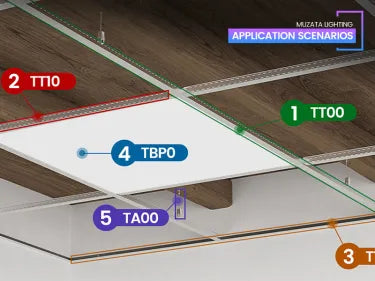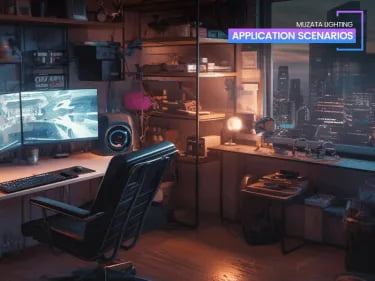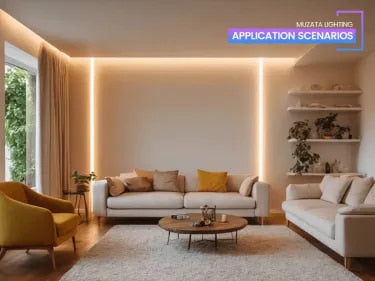TABLE OF CONTENTS
From Dim to Dazzling: LED Channel Lighting Tips for Tiny House Decor

Tiny house living is a growing phenomenon, captivating the hearts of those seeking a simpler, more sustainable lifestyle. As these compact dwellings rise in popularity, homeowners are continually looking for innovative ways to enhance their small spaces. One such method is the use of LED channel lighting, which not only illuminates but also transforms tiny homes into cozy, functional havens. But how exactly can these lights make such a difference? Let’s explore.
The Rising Trend of Tiny House Living
The tiny house movement is driven by a desire to live minimally and sustainably. More people are downsizing to reduce their environmental footprint, lower their housing costs, and embrace a clutter-free lifestyle. According to the Tiny House Society, the average size of a tiny house is between 100 and 400 square feet, compared to the average American home, which is about 2,600 square feet. This drastic reduction in space encourages creative solutions for living comfortably.
Living in a smaller space offers numerous advantages. Financially, tiny homes are far more affordable than traditional homes, with prices ranging from $20,000 to $60,000 compared to the median U.S. home price of over $300,000. Environmentally, tiny homes require fewer resources to build and maintain, and they typically use less energy, resulting in lower utility bills and a smaller carbon footprint.
Statistics show a growing interest in tiny homes. A study by the National Association of Home Builders found that more than half of Americans would consider living in a home under 600 square feet. This trend is supported by numerous case studies, such as Jenna Spesard’s Tiny House Giant Journey, which showcases the financial and emotional benefits of downsizing. But what about making these tiny house decor feel spacious and inviting? That’s where lighting plays a crucial role.

Challenges of Tiny House Lighting
Proper lighting is crucial in any home, but it becomes even more important in a tiny house. Small spaces can easily feel cramped and dark, so effective lighting is essential to create a sense of openness and comfort. However, tiny house owners often face challenges such as limited natural light, insufficient electrical outlets, and the need for versatile lighting solutions that can adapt to multi-functional spaces. So, how do you overcome these challenges? The answer lies in LED channel lighting.
Introducing LED Channel Lighting

LED channel lighting is an innovative solution perfectly suited for tiny homes. These lights consist of LED strips housed in aluminum channels, providing a sleek, modern look. They are highly energy-efficient, consuming up to 75% less energy than incandescent bulbs and lasting up to 25 times longer. This means lower electricity bills and less frequent replacements, aligning perfectly with the sustainable ethos of tiny house decor. Additionally, LED channel lighting saves space, enhances ambiance, and adds a touch of fun to daily life.
Space Saving
The slim profile of LED channels makes them ideal for tiny house decor, where every inch counts. They can be discreetly installed in areas where traditional lighting fixtures might be too bulky.
Atmosphere Creation
LED channels can be used to create various lighting effects, from a soft, warm glow for relaxation to bright, focused light for tasks. This versatility helps set the mood and make tiny house decor feel more inviting.
Adding a Touch of Fun
The wide range of colors and lighting modes available in LED strips allows tiny house decor homeowners to customize their lighting setup to match their mood or decor, adding a playful and dynamic element to their living space.
With these benefits in mind, how can you maximize the impact of LED channel lighting in your tiny home?
Enhancing the Tiny Tiny House Decor Experience with LED Channel Lighting
LED channel lighting can dramatically enhance the ambiance and functionality of a tiny house. Here are some ways to maximize its benefits:
Creating a Welcoming and Cozy Ambiance
LED channel lights can be installed under cabinets, along ceilings, or behind shelves to create a warm, inviting atmosphere. For example, placing 4-6 feet of LED channels under kitchen cabinets can provide focused lighting for meal preparation, while also adding a touch of elegance.
Maximizing Space Utilization
Strategic placement of LED lights can make a small space appear larger. Cove lighting along the top edges of walls or ceilings can add depth and dimension, making the room feel more expansive. Typically, 10-12 feet of LED channel lighting can effectively illuminate an average tiny house living area.
Showcasing Creative Lighting Ideas
Consider using LED channels to highlight architectural features or artwork. Installing 2-4 feet of LED channels behind bookshelves or around mirrors can create stunning visual effects, enhancing the overall aesthetic of your tiny home.
Ready to bring these benefits to your tiny house? Let’s dive into the practical steps.
Practical Tips for Incorporating LED Channel Lighting in a Tiny House Decor
Integrating LED channel lighting into your tiny house decor is a straightforward process, but it requires careful planning and execution to make the most of your limited space. Here’s a detailed step-by-step guide:
Plan Your Layout
- Assess Your Space: Begin by creating a detailed floor plan of your tiny house, including loft areas, stairs, and multi-functional spaces.
- Identify Key Areas: Highlight areas that require illumination, such as countertops, under cabinets, stairs, sleeping lofts, and seating areas.
- Consider Activities: Think about the different activities that will take place in each area. For example, task lighting is essential for kitchens and workspaces, while ambient lighting is perfect for living and sleeping areas.
Choose the Right LED Channels
- Design Preferences: Select LED channels that complement your interior tiny house decor. Aluminum channels come in various finishes like matte, brushed, or glossy to match your decor.
- Functional Needs: Consider the type of light you need. Warm white LEDs (2700K-3000K) are ideal for creating a cozy atmosphere, while cool white LEDs (4000K-5000K) are better for tasks.
- Brightness: Measure the brightness in lumens. For instance, task areas might require 300-500 lumens per square foot, while ambient lighting could be lower.
Measure and Cut
- Accurate Measurements: Measure the length of areas where you plan to install LED channels. Ensure you have accurate dimensions to avoid gaps or overlaps.
- Custom Fit: Most LED strips can be cut every few inches (typically every 2-4 inches), allowing for precise customization to fit your space perfectly.
Install the Channels
- Securing Channels: Use screws or adhesive backing to secure the aluminum channels to surfaces. Ensure they are mounted flush to avoid shadows or gaps in the lighting.
- Insert LED Strips: Once the channels are in place, insert the LED strips. Some channels come with a diffuser cover to soften the light and distribute it evenly.
Connect to Power
- Power Source: Connect the LED strips to a power source. This might involve running cables to existing outlets or installing new ones if necessary.
- Dimmer Switches: Install dimmer switches to control the brightness of your LED lights, allowing for flexible lighting options based on your needs.
Maximize Space

- Under Cabinet Lighting: Install LED channels under kitchen cabinets to illuminate countertops and enhance the cooking experience. This can typically be done with 4-6 feet of LED channels.

- Stair Lighting: For lofts, installing LED channels along the stairs or the underside of each step can improve safety and add a modern touch. Use 3-5 feet of LED channels per staircase.

- Loft Lighting: In the sleeping loft, install LED channels along the edge of the ceiling or the base of the bed for soft, ambient lighting. About 5-7 feet of LED channels should be sufficient.
But are LED channels the only option? Let’s look at other smart lighting solutions.
Other Smart Lighting Solutions for Tiny Houses
While LED channel lighting is an excellent choice, there are other smart lighting solutions worth considering:
- Recessed Lighting: Space-saving and unobtrusive, recessed lights are perfect for tiny homes with low ceilings.
- Track Lighting: Flexible and adjustable, track lighting allows you to direct light where it’s needed most.
- Solar-Powered Lights: Ideal for off-grid tiny houses, solar lights reduce energy consumption and provide eco-friendly illumination.
Each lighting solution has its pros and cons. For example, recessed lighting saves space but can be challenging to install, while solar-powered lights are sustainable but dependent on sunlight availability. So, which one fits your tiny house best?
Conclusion
LED channel lighting offers a transformative solution for enhancing tiny house living. By providing efficient, versatile, and aesthetically pleasing illumination, LED lights help create a comfortable, inviting, and functional space. As you embark on your tiny house journey, consider the magic of LED channel lighting to illuminate your path to a brighter, more sustainable future. Explore the possibilities and let your tiny home shine with the brilliance of LED innovation. Ready to light up your tiny home? The possibilities are endless!




